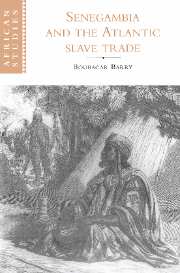Book contents
- Frontmatter
- Contents
- Preface
- Map
- I Senegambia from the fifteenth to the seventeenth century: a haven for incoming populations, a station for migrants on the move
- II Senegambia in the eighteenth century: the slave trade, ceddo regimes and Muslim revolutions
- 5 The slave trade in the eighteenth century
- 6 The strengthening of ceddo regimes in the eighteenth century
- 7 Muslim revolutions in the eighteenth century
- 8 The impact of the slave trade: economic regression and social strife
- III Senegambia in the first half of the nineteenth century: legitimate trade and sovereignty disputes
- IV Senegambia in the second half of the nineteenth century: colonial conquest and resistance movements
- Conclusion
- Notes
- Bibliography
- Index
- Other books in the series
6 - The strengthening of ceddo regimes in the eighteenth century
Published online by Cambridge University Press: 31 October 2009
- Frontmatter
- Contents
- Preface
- Map
- I Senegambia from the fifteenth to the seventeenth century: a haven for incoming populations, a station for migrants on the move
- II Senegambia in the eighteenth century: the slave trade, ceddo regimes and Muslim revolutions
- 5 The slave trade in the eighteenth century
- 6 The strengthening of ceddo regimes in the eighteenth century
- 7 Muslim revolutions in the eighteenth century
- 8 The impact of the slave trade: economic regression and social strife
- III Senegambia in the first half of the nineteenth century: legitimate trade and sovereignty disputes
- IV Senegambia in the second half of the nineteenth century: colonial conquest and resistance movements
- Conclusion
- Notes
- Bibliography
- Index
- Other books in the series
Summary
The Atlantic trading system in general, and the slave trading aspect of it in particular, gave the evolution of economic, political, and social structures in Senegambia during the eighteenth century a peculiar spin. Each state, depending on how close it was to the coast and the influences of the Atlantic trading system, went through a pattern of internal development which tended to reflect various aspects of the quasi-permanent economic, political and social crisis ravaging the territory in this time of generalized violence. In northern Senegambia, following the failure of the marabout movement at the end of the eighteenth century, the aristocracies of Kajoor, Waalo, Futa Toro, and Gajaaga, who had a stake in the Atlantic trading system, became even more warlike. They reinforced their centralizing authority, all the while enduring the pressure of the emirates of Trarza and Brakna, which were every bit as warlike.
In southern Senegambia, the kingdom of Kaabu decimated the population divided into a patchwork of small states in the Southern Rivers area, using a powerful war machine devoted exclusively to manhunts.
Ceddo regimes emerged during the eighteenth century in most of the Senegambian states. They came to symbolize the reign of violence in political relationships between and within states. Organized, massive manhunts created objective conditions for this violence. Violence became self-perpetuating in an infernal spiral of civil strife and inter-state wars that wasted the country and brought profits to European markets along the Senegambian coast.
- Type
- Chapter
- Information
- Senegambia and the Atlantic Slave Trade , pp. 81 - 93Publisher: Cambridge University PressPrint publication year: 1997

